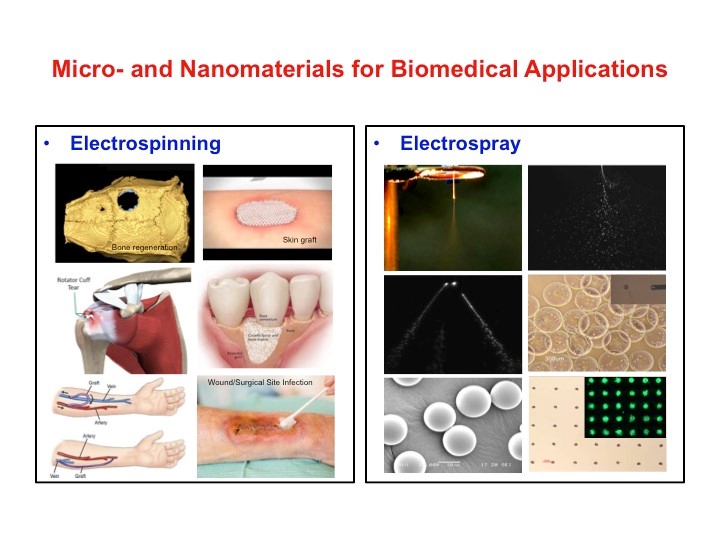
Jingwei Xie, PhD – Principal Investigator
Research Scientist and Professor
DRC II 6016
UNMC, Omaha, NE 68198-5965
Phone: 402-559-9442
EMAIL
Research
Xie laboratory’s research interests center on the synthesis, surface modification, self-assembly of materials at nanometer scale to address problems in the field of tissue engineering, regenerative medicine and drug/gene delivery. Our research programs are built upon interdisciplinary subjects including materials science, engineering, biology and medicine. We develop novel, smart biomaterials with well-controlled composition, structure and functional properties. We employ analytical tools in materials science, biology and medicine to characterize these biomaterials as either scaffolds or drug/gene carriers. Specifically, we are interested in use of nano-structured materials together with signaling molecules to regulate cell/stem cell behaviors for regenerating various types of tissues. We are also interested in developing nanofibrous materials for topical delivery of therapeutic agents (e.g., antimicrobial peptides, chemotherapeutic drugs, cytokines, and growth factors).

Publications
- Emerging roles of electrospun nanofibers in cancer research (Invited Review Article)
Chen S, Batra SK, Li X, Xie J*, Adv. Healthcare Mater. 2017, In press. - Nanofiber-based sutures induce endogenous antimicrobial peptide
Chen S, Ge L, Gombart AF, Shuler FD, Carlson MA, Reilly DA, Xie J*, Nanomedicine 2017, doi: 10.2217/nnm-2017-0161. - Electrospun nanofibers: new concepts, materials, and applications
Xue J, Xie J, Liu W, Xia Y, Account of Chemical Research 2017, 50, 1976-1987. - Binary doping of strontium and copper enhancing osteogenesis and angiogenesis of bioactive glass nanofibers while suppressing osteoclast activity
Weng L, Boda SK, Teusink MJ, Shuler FD, Li X, Xie J*, ACS Appl. Mater. Interfaces. 2017, 9, 24484-24496. - 3D nanofiber scaffolds with arrayed holes for engineering skin tissue constructs
Fu L, Carlson MA, Reilly DA, Xie J*, MRS Communication 2017, DOI: https://doi.org/10.1557/mrc.2017.49 - Recent advances in electrospun nanofibers for wound healing
Chen S, Liu B, Carlson MA, Gombart AF, Reilly DA, Xie J*, Nanomedicine 2017, 12, 1335-1352. - Thermally triggered mechanically destructive electronics based on electrospun poly(caprolactone) nanofibrous polymer films
Gao Y, Sim K, Yan X, Jiang J, Xie J, Yu C, Sci. Rep. 2017, 7, 947 - Twisting electrospun nanofiber fine strips into functional sutures for sustained co-delivery of gentamicin and silver
Chen S, Ge L, Carlson MA, Teusink MJ, Shuler FD, Xie J*, Nanomedicine: NBM, 2017, 13, 1435-144 - Expanded three-dimensional nanofiber scaffolds: cell penetration, neovascularization, and host response
Jiang J, Li Z, Wang H, Wang Y, Carlson MA, Teusink MJ, MacEwan MR, Gu L, Xie J*, Adv. Healthcare Mater. 2016, DOI: 10.1002/adhm.201600808. (Highlighted on the inside front cover and Materials View in China) - Highly controlled strontium-doped hydroxyapatite coating on electrospun PCL fibers
Weng L, Teusink MJ, Shuler FD, Xie J*, Journal of Biomedical Materials Research Part B, 2016, Doi: 10.1002/jbm.b.33598. - Expanding two-dimensional electrospun nanofiber membranes in the third dimension by a modified gas-foaming technique
Jiang J, Carlson MA, Teusink MJ, Wang H, MacEwan MR, Xie J*, ACS Biomater. Sci. Eng. 2015, 1, 991-1001. - Local sustained delivery of 25-hydroxyvitmain D3 for production of antimicrobial peptides
Jiang J, Chen G, Shuler FD, Wang CH, Xie J*, Pharm. Res. 2015, 32, 2851-2862. - Smart electrospun nanofibers for controlled drug release: recent advances and new perspectives
Weng L, Xie J*, Curr. Pharm. Des. 2015, 21, 1944-1959. (Invited review article) - Electrospun nanofiber scaffolds with gradations in fiber organization
Khandalavala K, Jiang J, Shuler FD, Xie J*, Journal of Visualized Experiments, 2015, 98, doi: 10.3791/52626. - Electrohydrodynamic atomization: a two-decade effort to produce and process micro-/nanoparticulate materials
Xie J*, Jiang J, and Wang CH, Chemical Engineering Science, 2015, 125, 32-57. (Invited review article) - Nerve guidance conduits based on double-layered scaffolds of electrospun nanofibers for repairing the peripheral nervous system
Xie J, MacEwan MR, Liu W, Jesuraj N, Li X, Hunter D, Xia Y, ACS Applied Materials & Interface 2014, 6(12), 9472-9480. - Nanofiber scaffolds with gradients in mineral content for spatial control of osteogenesis
Liu W, Lipner J, Xie J, Manning CN, Thomopoulos S, Xia Y, ACS Applied Materials & Interface 2014, 6(4), 2842-2849. - Neurite outgrowth on electrospun nanofibers with uniaxial alignment: the effects of fiber density, surface coating, and supporting substrate
Xie J, Liu W, MacEwan MR, Bridgman PC, Xia Y, ACS Nano 2014, DOI: 10.1021/nn406363j. - Biomimetic nanofiber scaffolds for tendon-to-bone insertion repair
Xie J*, Ma B, Shuler FD, Advanced Materials Research 2014, 875-877, 331-334. - A mussel-inspired coating finely tailoring pH-responsive drug delivery from electrospun nanofibers
Jiang J, Xie J*, Ma B, Bartlett DE, Wang CH, Acta Biomaterialia, 2014, 10, 1324-1332. - Sandwich-type fiber scaffolds with square arrayed microwells and nanostructured cues as microskin grafts for skin regeneration
Ma B, Xie J*, Jiang J, and Wu J, Biomaterials 2014, 35, 630-641. - Rational design of nanofiber scaffolds for orthopaedic tissue repair and regeneration
Ma B, Xie J*, Jiang J, Shuler FD, Bartlett DE, Nanomedicine 2013, 8, 1459-1481. - Controlled delivery of mesenchymal stem cells and growth factors using a tendon-specific nanofiber scaffold
Mannning CN, Schwartz AG, Liu W, Xie J, Sakiyama-Elbert S, Silva MJ, Xia Y, Gelberman RH, Thomopoulos S, Acta Biomaterialia, 2013, 9(6), 6905-6914. - Controlled biomineralization of electrospun poly(ε-caprolactone) fibers for enhancing their mechanical properties
Xie J*, Zhong S, Ma B, Shuler FD, Lim CT, Acta Biomaterialia , 2013, 9, 5698-5707. - Proliferation of genetically modified human cells on electrospun nanofiber scaffolds
Borjigin M, Strouse B, Bialk P, Eskridge C, Niamat R, Xie J, Kmiec EB, Molecular Therapy-Nucleic Acids, 2012, 1(12): e59. - Fabrication of novel 3D nanofiber scaffolds with anisotropic property and regular pores and their potential applications
Xie J*, Ma B, Michael PL, Advanced Healthcare Materials, 2012, 1, 674-678. - Fabrication of nanofiber scaffolds with gradations in fiber organization and their potential applications.
Xie J*, Michael PL, Ma B, Shuler FD, Macromolecular Biosciences, 2012, 12:1336-1341. - Mussel inspired protein-mediated surface modification to electrospun fibers and their potential biomedical applications
Xie J*, Michael PL, Zhong S, Ma B, MacEwan MR, Lim CT, Journal of Biomedical Materials Research Part A, 2012, 100A, 929-938. - Submicron bioactive glass tubes for bone tissue engineering
Xie J*, Blough EK, and Wang CH, Acta Biomaterialia, 2012, 8, 811-819. (Corresponding author) - Enhancing the stiffness of electrospun nanofiber scaffolds with a controlled surface coating and mineralization
Liu W, Yeh YC, Lipner J, Xie J, Sung HW, Thomopoulos S and Xia Y, Langmuir, 2011, 27, 9088-9093. - Nanofiber membranes with controllable microwells and structural cues and their use in forming cell microarrays and neuronal networks
Xie J, Liu W, MacEwan MR, Yeh YC, Thomopoulos S and Xia Y, Small, 2011, 7, 293-297. (This article was featured on the cover.) - Radially aligned, electrospun nanofibers as dural substitutes for wound closure and tissue regeneration applications
Xie J, MacEwan MR, Ray WZ, Liu W, Siewe DY and Xia Y, ACS Nano, 2010, 4, 5027-5036. (This article was featured on the cover, highlighted in Chemical& Engineering News and Spotlight section on Nanowerk web) - Nanoparticulate formulations for paclitaxel delivery across MDCK cell monolayer
Xie J, Lei C, Hu Y, Gay GK, Jamali NHB and Wang CH, Current Pharm. Design, 2010, 16, 2331-2340. (This article was highlighted on the cover.) - “Aligned-to-random” nanofiber scaffolds for mimicking the structure of tendon-to-bone insertion site
Xie J, Li X, Lipner J, Wolfe C, Schwartz AG, Thomopoulos S and Xia Y, Nanoscale, 2010, 2, 923-926. - Fabrication of density gradients of biodegradable polymer microparticles and their use in guiding neurite outgrowth
Li X, MacEwan MR, Xie J, Siewe D, Yuan X and Xia Y, Adv. Funct. Mater., 2010, 20, 1632- 1637. - Electrospun nanofibers for neural tissue engineering
Xie J, MacEwan MR, Schwartz GA and Xia Y, Nanoscale, 2010, 2, 35-44. (In February 2010, this article was amongst the top ten accessed articles from the online version of Nanoscale, http://www.rsc.org/Publishing/Journals/nr/top10.asp.) - Electric field controlled electrospray deposition for precise particle pattern and cell pattern formation
Xie J, Rezvanpour A, Wang CH and Hua J, AICHE Journal, 2010, 56, 2607-2621. - Gold nanocages covered with smart polymers: A new platform for controlled release using near-infrared light
Yavuz MS, Cheng Y, Cobley CM, Zhang Q, Rycenga M, Xie J, Kim C, Song KH, Schwartz AG, Wang LV and Xia Y, Nature Mater., 2009, 8, 935-939. - Understanding the role of surface charges in cellular adsorption versus internalization by selectively removing gold nanoparticles on the cell surface with a I2/KI etchant
Cho EC, Xie J, Wurm P and Xia Y, Nano Lett., 2009, 9, 1080-1084. - Chitosan inverse opal scaffold with uniform pore structure for three-dimensional cell culture
Choi SW, Xie J and Xia Y, Adv. Mater., 2009, 21, 2997-3001. - Conductive core-sheath nanofibers and their potential application in neural tissue engineering
Xie J, Macewan MR, Li X, Daniel M, Sakiyama-Elbert SE and Xia Y, Adv. Funct. Mater., 2009, 19, 2312-2318. - Neurite outgrowth on nanofiber scaffolds with different structures, orders, and surface properties
Xie J, Macewan MR, Willerth SM, Li X, Sakiyama-Elbert SE and Xia Y, ACS Nano. 2009, 3, 1151-1159. (This work was highlighted on the cover, and featured on Audio/podcast http://pubs.acs.org/page/ancac3/audio/index.html) - Nanofiber scaffolds with gradations in mineral content for mimicking the tendon-to-bone insertion site
Li X, Xie J, Lipner J, Yuan X, Thomopoulos S and Xia Y, Nano Lett., 2009, 9, 2763-2768. (This work was featured in Chemical & Engineering News, on the Nanotechweb, and in the November issue of Discover magazine, page 13) - Biomimetic electrospun poly(-caprolactone)/gelatin/calcium phosphate hybrid scaffolds for bone tissue engineering
Li X, Xie J, Yuan X and Xia Y, Langmuir, 2008, 24, 14145-14150. - The differentiation of embryonic stem cells seeded on electrospun nanofibers into neural lineages
Xie J, Willerth SM, Li X, Macewan MR, Rader A, Sakiyama-Elbert SE and Xia Y, Biomaterials, 2009, 30, 354-362. (Part of the work was highlighted in Nature Materials, 2008, 7, 760.) - Putting electrospun nanofibers to work for biomedical research
Xie J, Li X and Xia Y, Macromol. Rapid Comm., 2008, 29, 1775-1792. (Highlighted on the cover, most accessed articles 2/2009–1/2010, highlighted in Materials Views 2008, November A5) - Electrospinning: An enabling technique for nanostructured materials
Xie J and Xia Y. Material Matters, 2008, 3, 19-23. - Characterization of electrospraying process for polymeric particle fabrication
Yao J, Lim LK, Xie J, Hua J and Wang CH, J. Aero. Sci., 2008, 39, 987-1002. - Encapsulation of protein drugs in biodegradable microparticles by co-axial electrospray
Xie J, Ng WJ, Lee LY and Wang CH, J. Colloid Interface Sci., 2008, 317, 469-476. - Biodegradable films developed by electrospray deposition for sustained drug delivery
Xie J, Tan JC and Wang CH, J. Pharm. Sci., 2008, 97, 3109-3122. - Microparticles and fiber fabrics for the sustained delivery of cisplatin
Xie J, Tan RS and Wang CH, J. Biomed. Mater. Res., 2008, 85A, 897-908. - Electrospray in the dripping model for cell microencapsulation
Xie J and Wang CH, J. Colloid Interface Sci., 2007, 312, 247-255. - In vivo performance of implantable biodegradable preparations delivering Paclitaxel and Etanidazole for the treatment of glioma
Naraharisetti PK, Ong BYS, Xie J, Lee TKY, Wang CH and Sahinidis NV, Biomaterials, 2007, 28, 886-894. - Encapsulation of proteins in bio-degradable polymeric microparticles using electrospray in the Taylor cone-jet mode
Xie J and Wang CH, Biotech. & Bioeng., 2007, 97, 1278-1290. - Effect of PEG molecular weight and conformation on the interaction and cellular uptake efficiency of nanoparticles with Hep G2 cells
Hu Y, Xie J, Tong YW and Wang CH, J. Controlled Release, 2007, 118, 7-17. - Microparticles developed by electrohydrodynamic atomization for the local delivery of anticancer drug to treat C6 glioma in vitro
Xie J, Marijinissen JCM and Wang CH, Biomaterials, 2006, 27, 3321-3332. - Electrospun biodegradable micro- and nanofibers for the delivery of Paclitaxel to treat C6 glioma in vitro
Xie J and Wang CH, Pharm. Res., 2006, 23, 1817-1826. - Electrohydrodynamic atomization (EHDA) for biodegradable polymeric particle production
Xie J, Lim LK, Phua Y and Wang CH, J. Colloid Interface Sci., 2006, 302, 103-112. - Self-assembled biodegradable nanoparticles developed by direct dialysis for the delivery of paclitaxel
Xie J and Wang CH, Pharm. Res., 2005, 22, 2079-2090. - A controllable approach for the synthesis of titanate derivatives of potassium tetratitanate fiber
He M, Feng X, Lu X, Ji X, Liu C, Bao N and Xie J, J. Mater. Sci., 2004, 39, 3745-3750 - Application of an ion-exchange model to the synthesis of fibrous titanate derivatives
He M, Feng X, Lu X, Ji X, Liu C, Bao N and Xie J, J. Chem. Eng. Japan, 2003, 36, 1259-1262. - Atomic force microscopy (AFM) study on potassium hexatitanate whisker (K2O·6TiO2)
Xie J, Lu X, Zhu Y, Liu C and Bao N. J. Mater. Sci., 2003, 38, 3641-3646. - Preparation of titanium dioxide fibers and their photocatalysis reactivity
Yang ZH, Bao NZ, Liu C, Feng X, Xie J, Ji XY, Lu XH, Chemical Journal of Chinese Universities-Chinese, 2002, 23, 1371-1374. - Thermodynamic modeling and experimental verification for ion-exchange synthesis of K2O·6TiO2 and TiO2 fibers from K2O·4TiO2
Bao N, Lu X, Ji X, Feng X and Xie J, Fluid Phase Equilibria, 2002, 193, 229-243.
Patents
- Xie J, Nanofiber structures and methods of synthesis and modification, US provisional patent, No. 62560314, 2017.
- Xie J, Carlson MA, Expanded Nanofiber Scaffolds for Tissue Engineering, US provisional patent, No. 62517310, 2017.
- Xie J, Wang G, Nanofiber dressings for controlled delivery of peptides, US provisional patent No. 65/510,923, 2017.
- Xie J, Chen S, Carlson MA, Electrospun nanofiber-based hemostatic materials, US provisional patent No. 62400700, 2016.
- Xie J, Chen S, Baxter T, Ring and tubular devices for tailoring drug release and delivery, US provisional patent No. 62365023, 2016.
- Xie J, Jiang J, Nanofiber structures and methods of synthesis and use thereof. US provisional patent No. 62056899, 2014. PCT /US2015/052858. WO2016053988 A1.
- Xie J, Ma B, Nanofiber-based scaffolds and methods for repair skin injury in a large wound area. U.S. Patent Application Serial No. 61/666,260.
- Xie J, Nanofiber scaffolds and methods for repairing damaged cardiac tissue. U.S. Patent Application Serial No. 61/586,866, issued in Jan, 2017.
- Leuthardt E, Moran D, Holtzman D, Bayly P, Brody D, Dacey RG, Fok S, Garrison J, Genin G, Lusis E, Pappu R, Xie J, Zipfel G, Altering protein concentrations in cerebrospinal fluid and/or brain interstitial fluid. WIPO Patent Application WO/2012/145428. International Application No.: PCT/US2012/034120.
- MacEwan MR, Xie J, Ray WZ, Xia Y, Nanofiber dural substitute and nanofiber dural patch. U.S. Patent Application Serial No. 61/35572. MacEwan MR, Xie J, Ray WZ, Xia Y, Biomedical patches with aligned fibers. WO 2011/159889 A2, Pub. Date: Dec. 22, 2012. (This patent has been licensed by a company Acera Surgical Inc. St. Louis, the product was approved by FDA for pre-market in March 2016.)
- Thomopoulos S, Sakiyama-Elbert S, Silva M, Gelberman R, Xia Y, Schwartz A, Xie J, Nanofiber scaffolds for delivery of heparin binding growth factors. S. Patent Pub. No.: US 2013/0004541 A1, Pub. Date: Jan. 3, 2013.
Grants
- A pilot grant entitled “Novel 3D nanofiber aerogels for healing large cranial bone defects” from UNMC CDDN NIH COBRE June. 2017.
- A NE LB606 stem cell project grant entitled “3D nanofiber scaffolds homing stem cells for cartilage regeneration”. Oct. 2017.
- A 2017 Great Plains IDeA-CTR Pilot grant entitled “Injectable and Expandable Nanofiber Foams for Treating Noncompressible Hemorrhage”. June 2017.
- A National Institute of Health R01 grant entitled “Nanofiber-based delivery of combined immune-modulating compounds to minimize infection and enhance wound healing”, May 2017.
- A pilot grant entitled “Small Intestine Regeneration” from Regenerative Medicine Program. April 2017.
- A pilot grant entitled “Nanofiber Scaffolds for Cartilage Regeneration” from Regenerative Medicine Program. Nov. 2016.
- A pilot grant entitled “Nanofiber Scaffolds for Periodontal Bone Regeneration” from Regenerative Medicine Program. July 2016.
Lab Members

Principal Investigator
Dr. Jingwei Xie
Dr. Jingwei Xie was born in Anhui province, China in 1977. He received his BS and MS degrees in 1999 and 2002, respectively, from the Department of Chemical Engineering, Nanjing University of Technology (with Prof. Xiaohua Lu). He then continued his PhD study in the Department of Chemical and Biomolecular Engineering, National University of Singapore (with Prof. Chi-Hwa Wang). His doctoral thesis was mainly focused on the development of biomedical devices using electrohydrodynamic atomization. He received his PhD in 2007 and immediately joined Prof. Younan Xia’s group as a postdoctoral research associate at Washington University in St. Louis (2007-2011), where his research centered on the development of electrospinning for fabrication of nanofiber scaffolds, with a focus on their biomedical applications. Since 2011, he became the senior scientist of Marshall Institute for Interdisciplinary Research, Marshall University. He then relocated to University of Nebraska Medical Center (UNMC) in 2014. He is currently an Assistant Professor in Department of Surgery-Transplant and Holland Regenerative Medicine Program at UNMC. His research interests include nano-/micro-fabrication, biomaterials, stem cell therapy, regenerative medicine, and drug delivery.
Google Scholar: https://scholar.google.com/citations?user=FT44FUUAAAAJ&hl=en
Research gate: https://www.researchgate.net/profile/Jingwei_Xie
Postdoctoral Research Fellow

Dr. Shixuan Chen
Dr. Shixuan Chen was born in Anhui province, China. He received his BS degree in Pharmaceutical Engineering from the Huaihai Institute of Technology in 2010, and a PhD degree in Medicine from the Southern Medical University in 2015. He joined Xie Lab in November 2015 as a postdoctoral research fellow. His research interests include wound healing, vascular growth, and small intestine tissue engineering.
Postdoctoral Research Fellow

Yajuan Su, PhD
Dr. Yajuan Su was born in Jiangxi Province, China. She obtained her PhD (2017) degrees from Center for Biomedical Engineering and Regenerative Medicine, Frontier Institute of Science and Technology at Xi’an Jiaotong University. She joined Xie Lab as a postdoctoral research fellow in Apr. 2018. Her research interests include antimicrobial and antibiofilm biomaterials, vitamin D3 delivery, surgical site infection, and chronic wound healing.
Postdoctoral Research Fellow

Dr. Johnson V. John
Dr. Johnson V. John was born in India. He completed my Bachelor’s degree in Chemistry from Kannur University, India in 2005 and Master’s degree in Biochemistry from Bharathidasan University, India in 2008. He worked as a scientific assistant under the guidance of Dr. V. V. Pillay in Department of Forensic Toxicology Amrita Institute of Medical Science (2010–2011). Then he completed his Ph.D (2011-2016) under the supervision of Professor IL Kim in the Department of Polymer Science and Engineering at Pusan National University, Republic of Korea. His doctoral researches were focused on the synthesis of novel biomaterials like stimuli-responsive synthetic polymer-block-polypeptide and lipopolymers for various biomedical applications, especially for anticancer drug delivery, nucleic acid delivery, and photodynamic therapy. He was a postdoctoral research associate in Ingenuity Lab and Alberta Diabetic Institute under the direction of Prof. Dr. Carlo Montemagno and Prof. Gregory S. Korbutt at University of Alberta, Canada (2016-2017). There he has worked on a project related to “Islet transplantation”. His responsibility was with the preparation of novel polymer based scaffolds (Electro-spun fiber, hydrogel and other porous scaffold) for the islet transplantation. Moreover, he has completed a mini project on a degradable mesoporous nanoparticle for the intracellular delivery of cancer therapeutics. He will join Xie lab in Jan. 2018. His research interests include development of novel biomaterials for both regenerative and nanomedicine. At free time he enjoyed watching Soccer, playing Chess, and watching news etc.
Graduate Student

Alec McCarthy, BS
Alec McCarthy was born in Chicago, Illinois, but calls Omaha, Nebraska home. He graduated with a Bachelor’s in Biological Systems Engineering with a minor in Biomedical Engineering from the University of Nebraska – Lincoln, where he was an NIH INBRE scholar. During his undergraduate, he worked on non-viral gene delivery strategies in Dr Angela Pannier’s lab at UNL, small molecule synthesis and peptide chemistry in Dr Martin Conda-Sheridan’s lab at UNMC, and smart biomedical devices for wound healing in Dr Ali Tamayol’s lab at UNL. He joined the Xie Lab as the first student in the Regenerative Medicine & Biomaterials Design program in January 2019. His research interests include tissue engineering and wound healing, minimally-invasive surgery, biomaterial science, and process engineering.
Visiting Scholar

Jufei Xu, BE, MS
Jufei Xu was born in Henan province, China. She received her B.E. in College of Food and Biological Engineering from the Henan University of Science and Technology in 2012, and a M.E. degree in College of Life Science and Technology from Xinjiang University in 2015. Now she is studying for her Ph.D .degree at Renmin University of China. She joined Xie Lab in February 2020 as a visiting scholar. Her research interests focus on ‘3D Scaffolds Preparation by Melt Electrospinning Writing for Biomedical Applications’.
Technician

Mr. Hongjun Wang
Hongjun Wang was born in Ziyang, Sichuan province, China. He received his BS degree in Animal Medicine from Huazhong Agricultural University in 2009. After working in Pharmaron (China), he joined Xie Lab as a technician after being a volunteer in February 2015. His research interests include animal handling and animal surgeries.
Collaborators
Prof. Mark A. Carlson, MD, UNMC
Prof. Guangshun Wang, PhD UNMC
Prof. Dong Wang, PhD UNMC
Prof. B. Timothy Baxter, MD, UNMC
Prof. Debra A. Reilly, MD, UNMC
Prof. Ronald R. Hollins, MD, UNMC
Prof. Matthew J. Teusink, MD, UNMC
Prof. Adrian F. Gombart, PhD Oregon State University
Prof. Indra Arup, PhD Oregon State University
Prof. Yu Shrike Zhang, PhD Harvard University

